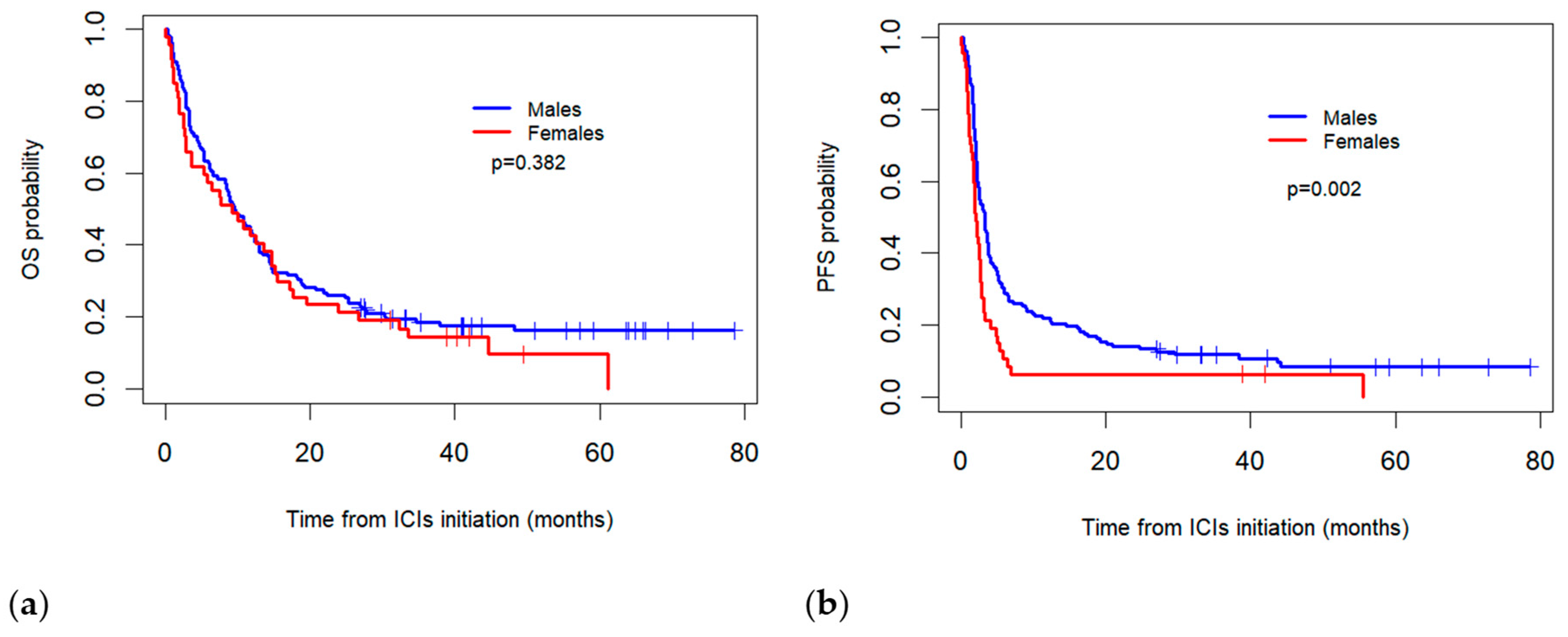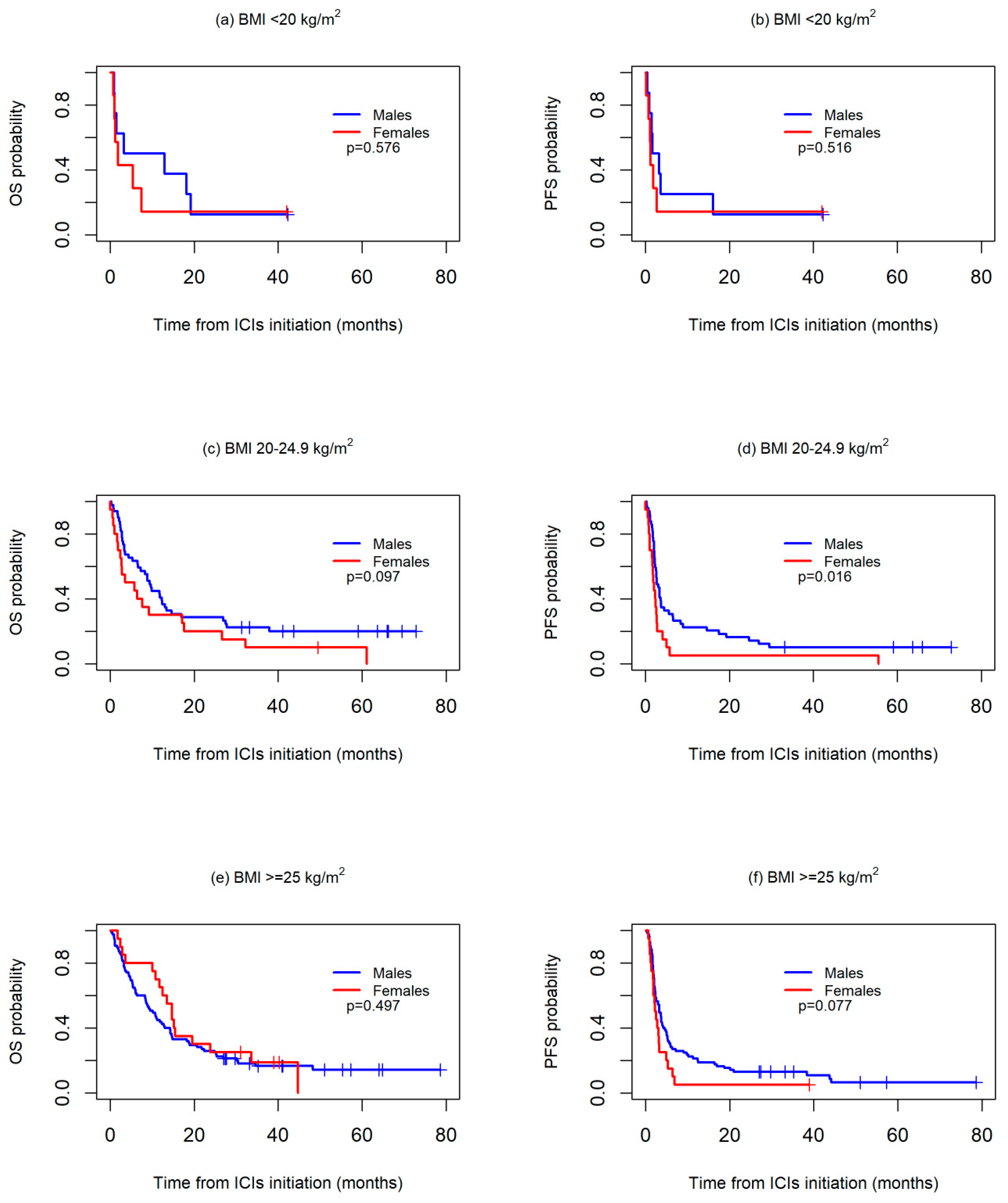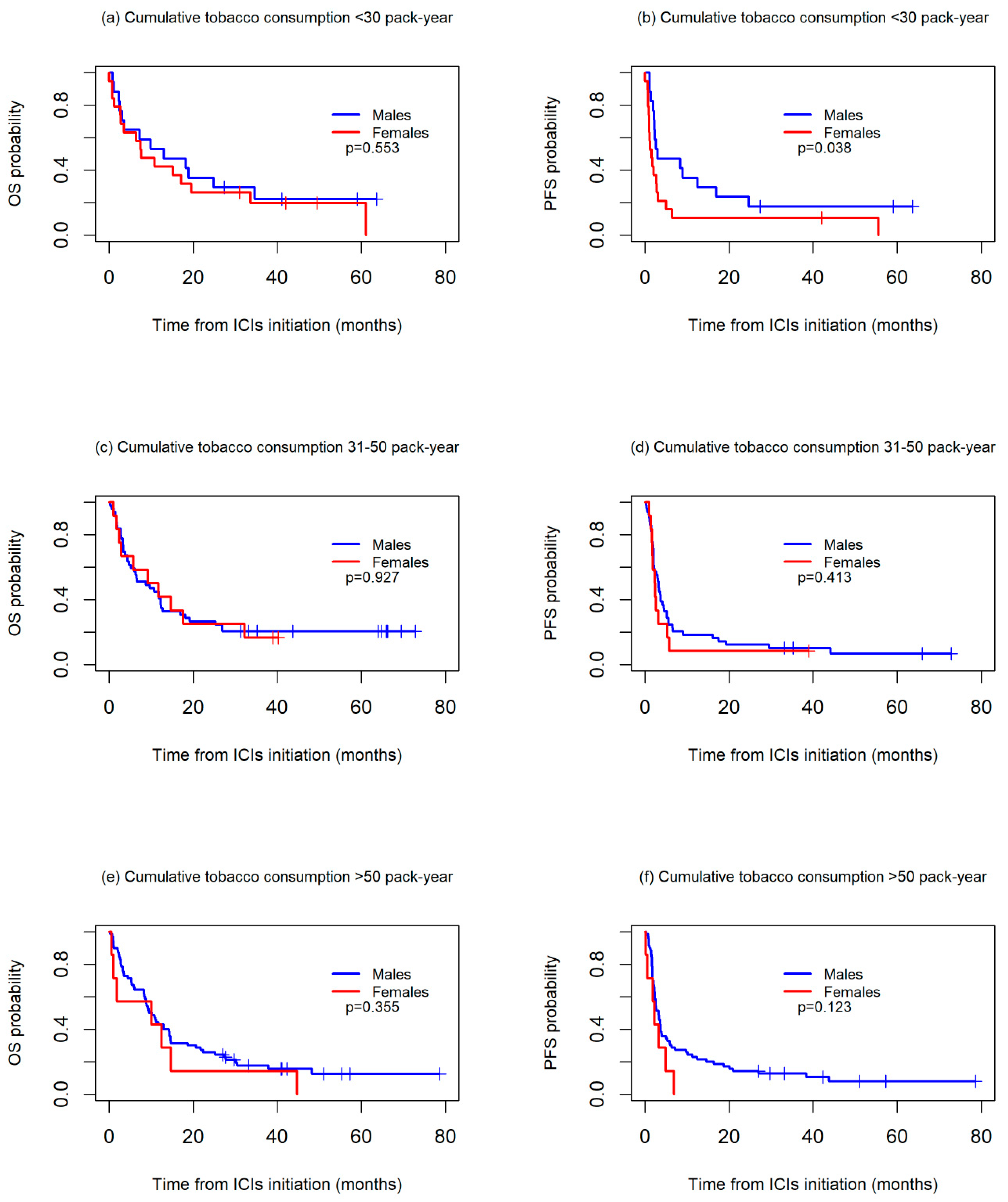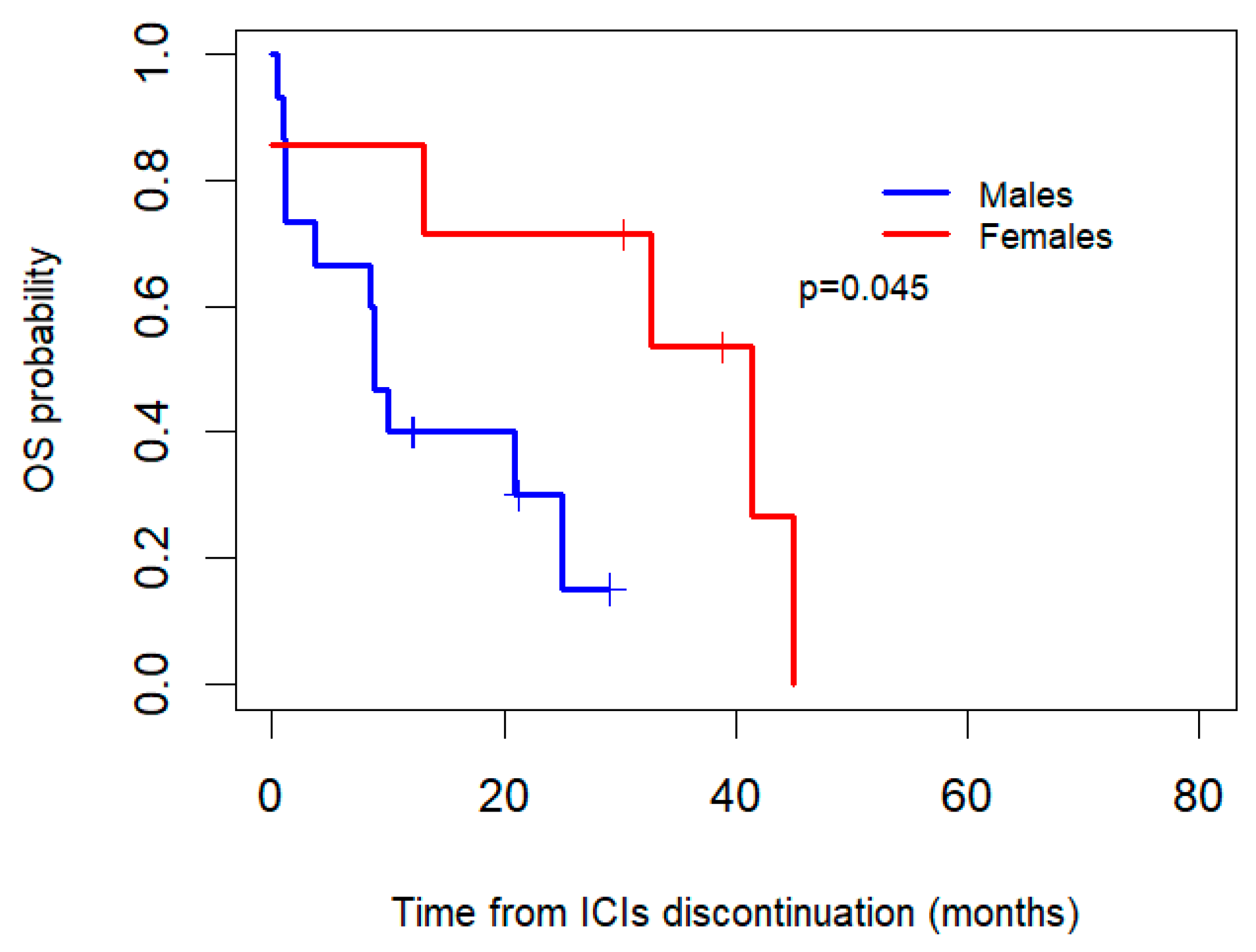Effect of Gender on Patients with Non-Small-Cell Lung Cancer Treated with Immune Checkpoint Inhibitors: A Real-World Study
Abstract
1. Introduction
| Reference | Tumor | Type of Drug (ICI) | Efficacy |
|---|---|---|---|
| (2017) [13] | NSCLC, melanoma, renal, and urothelial | PD-1 and CTLA-4 | Anti PD-1: OS without statistical significance in men: HR 0.72 vs. 0.81, p = 0.285. CTLA-4, OS HR 0.65 men vs. 0.79 women, p = 0.078. |
| [14] | NSCLC, melanoma, renal, urothelial, gastric, and head and neck | PD-1, PDL-1, and CTLA-4 | Similar benefit, slightly higher OS in men: HR 0.73 vs. 0.77, p < 0.001. CTLA-4 OS benefit in men: HR 0.77 (p = 0.0012) vs. HR 0.89 (p = 0.162). |
| [15] | NSCLC andmelanoma | PD-1, PDL-1, and CTLA-4 | Similar benefit, slightly greater in men: HR 0.62 vs. 0.74, p = 0.373. |
| [3] | NSCLC | PD-1, EGFR, and ALK | Women have a lower risk of cancer-specific death (HR = 0.73; p < 0.00001). OS with EGFR is better in women (HR:0.34 vs. HR: 0.44). Similar OS with ALK (HR: 0.51 vs. HR: 0.48; p < 0.00001). |
| [16] | NSCLC | PD-1 and PDL-1 | A better combination of QT and immunotherapy in women: HR 0.48 vs. 0.76. No benefit of immunotherapy alone in women HR 0.78 vs. 0.97, p = 0.002. |
| [17] | NSCLC | PD-1, PDL-1, and CTLA-4 | No significant difference in OS: HR 0.75 vs. 0.77, p = 0.6. |
| [18] | NSCLC | PD-1 and PDL-1 | More consistent and favorable ICI results in male patients than in female patients. |
| [19] | NSCLC | PD-1, PDL-1, and CTLA-4 | Greater benefit in men: HR 0.68 vs. 0.82 in women, p < 0.05. |
| [20] | NSCLC | PD-1, PDL-1, and CTLA-4 | Greater OS benefit in men (squamous) (HR: 0.73, 95% CI 0.58–0.91) vs. women (HR: 0.74, 95% CI 0.37–1.48). |
| [21] | NSCLC | PD-1 and PDL-1 | No significant difference in OS in men vs. women: HR 0.74 (95% CI 0.66–0.83) vs. 0.72 (95% CI 0.63–0.82), p = 0.709, nor PFS HR 0.63 (95% CI 0.53–0.75) vs. 0.72 (95% CI 0.58–0.88), p = 0.372. |
| (2022) [22] | NSCLC | Inhibidor de PD-1 and PDL-1 | No significant differences in OS (p = 0.054): Greater trend towards better PFS in men vs. women (HR = 5 vs. 4.5, p = 0.133). |
2. Materials and Methods
2.1. Study Design
2.2. Statistical Analysis
3. Results
4. Discussion
5. Conclusions
Author Contributions
Funding
Institutional Review Board Statement
Informed Consent Statement
Data Availability Statement
Acknowledgments
Conflicts of Interest
Abbreviations
| BMI | body mass index |
| CI | confidence interval |
| ECOG | Eastern Cooperative Oncology Group |
| HR | Hazard Ratio |
| OS | overall survival |
| PFS | progression-free survival |
| ICI | immune checkpoint |
| NSCLC | non small lung cell cancer |
| LC | lung cancer |
| PD-1 | Programmed Death-1 |
| PD-1L | Programmed Death-Ligand 1 |
References
- Bray, F.; Laversanne, M.; Sung, H.; Ferlay, J.; Siegel, R.L.; Soerjomataram, I.; Jemal, A. Globalcancerstatistics2022: GLOBOCAN estimates of incidence and mortality world wide for 36 cancers in 185 countries. CA Cancer J. Clin. 2024, 74, 229–263. [Google Scholar] [CrossRef] [PubMed]
- Guevara, M.; Molinuevo, A.; Salmerón, D.; Marcos-Gragera, R.; Carulla, M.; Chirlaque, M.D.; Rodríguez Camblor, M.; Alemán, A.; Rojas, D.; Vizcaíno Batllés, A.; et al. Cancer Survival in Adults in Spain: A Population-Based Study of the Spanish Network of Cancer Registries (REDECAN). Cancers 2022, 14, 2441. [Google Scholar] [CrossRef] [PubMed] [PubMed Central]
- Pinto, J.A.; Vallejos, C.S.; Raez, L.E.; Mas, L.A.; Ruiz, R.; Torres-Roman, J.S.; Morante, Z.; Araujo, J.M.; Gómez, H.L.; Aguilar, A.; et al. Gender and outcomes in non-small cell lung cancer: An old prognostic variable comes back for targeted therapy and immunotherapy? ESMO Open 2018, 3, e000344. [Google Scholar] [CrossRef]
- Borghaei, H.; Paz-Ares, L.; Horn, L.; Spigel, D.R.; Steins, M.; Ready, N.E.; Chow, L.Q.; Vokes, E.E.; Felip, E.; Holgado, E.; et al. Nivolumab versus Docetaxel in Advanced Non squamous Non-Small-Cell Lung Cancer. N. Engl. J. Med. 2015, 373, 1627–1639. [Google Scholar] [CrossRef] [PubMed]
- Brahmer, J.; Reckamp, K.L.; Baas, P.; Crinò, L.; Eberhardt, W.E.; Poddubskaya, E.; Antonia, S.; Pluzanski, A.; Vokes, E.E.; Holgado, E.; et al. Nivolumab versus Docetaxel in Advanced Squamous-Cell Non-Small- Cell Lung Cancer. N. Engl. J. Med. 2015, 373, 123–135. [Google Scholar] [CrossRef] [PubMed]
- Rittmeyer, A.; Barlesi, F.; Waterkamp, D.; Park, K.; Ciardiello, F.; von Pawel, J.; Gadgeel, S.M.; Hida, T.; Kowalski, D.M.; Dols, M.C.; et al. Atezolizumab versus docetaxel in patients with previously treated non-small-cel llung cancer (OAK): A phase 3, open-label, multicentre randomised controlled trial. Lancet 2017, 389, 255–265. [Google Scholar] [CrossRef]
- Reck, M.; Rodríguez-Abreu, D.; Robinson, A.G.; Hui, R.; Csőszi, T.; Fülöp, A.; Gottfried, M.; Peled, N.; Tafreshi, A.; Cuffe, S.; et al. Pembrolizumab versus Chemotherapy for PD-L1- Positive Non-Small-Cell Lung Cancer. N. Engl. J. Med. 2016, 375, 1823–1833. [Google Scholar] [CrossRef]
- Díaz-Carrasco, M.S.; González-Haba, E.; García-Soler, J.I.; Espuny-Miró, A. Predictive biomarkers of response to immune check point inhibitors. Farm. Hosp. 2021, 45, 141–148. [Google Scholar]
- Gee, K.; Yendamuri, S. Lung cancer in females-sex-based differences from males in epidemiology, biology, and outcomes: A narrative review. Transl. Lung Cancer Res. 2024, 13, 163–178. [Google Scholar] [CrossRef]
- Kimbrough, E.O.; Marin-Acevedo, J.A.; Drusbosky, L.M.; Mooradian, A.; Zhao, Y.; Manochakian, R.; Lou, Y. Sex-andAge-Associated Differences in Genomic Alterations among Patients with Advanced Non-Small Cell Lung Cancer (NSCLC). Cancers 2024, 16, 2366. [Google Scholar] [CrossRef]
- Wallen, Z.D.; Ko, H.; Nesline, M.K.; Hastings, S.B.; Strickland, K.C.; Previs, R.A.; Zhang, S.; Pabla, S.; Conroy, J.; Jackson, J.B.; et al. Real-world comprehensive genomic and immune profiling reveals distinctage-and sex-based genomic and immune landscapes in tumors of patients with non-small cell lung cancer. Front. Immunol. 2024, 15, 1413956. [Google Scholar] [CrossRef] [PubMed]
- Rosique-Aznar, C.; Valcuende-Rosique, A.; Rosique-Robles, D.; Sánchez-Alcaraz, A. Relationship between Lactate Dehydrogenase and survival in patients with non-smallcell lung cancer receiving immunotherapy. FarmHosp. 2024, in press. [Google Scholar]
- Botticelli, A.; Onesti, C.E.; Zizzari, I.; Cerbelli, B.; Sciattella, P.; Occhipinti, M.; Roberto, M.; Di Pietro, F.; Bonifacino, A.; Ghidini, M.; et al. The sexist behaviour of immune check point inhibitors in cancer therapy? Oncotarget 2017, 8, 99336–99346. [Google Scholar] [CrossRef] [PubMed]
- Grassadonia, A.; Sperduti, I.; Vici, P.; Iezzi, L.; Brocco, D.; Gamucci, T.; Pizzuti, L.; Maugeri-Saccà, M.; Marchetti, P.; Cognetti, G.; et al. Effect of Gender on the Outcome of Patients Receiving Immune Check point Inhibitors for Advanced Cancer: A Systematic Review and Meta-Analysis of Phase III Randomized Clinical Trials. J. Clin. Med. 2018, 7, 542. [Google Scholar] [CrossRef] [PubMed]
- Wu, Y.; Ju, Q.; Jia, K.; Yu, J.; Shi, H.; Wu, H.; Jiang, M. Correlation between sex and efficacy of immune check point inhibitors (PD-1 and CTLA-4 inhibitors). Int. J. Cancer 2018, 143, 45–51. [Google Scholar] [CrossRef]
- Conforti, F.; Pala, L.; Bagnardi, V.; Viale, G.; DePas, T.; Pagan, E.; Pennacchioli, E.; Cocorocchio, E.; Ferrucci, P.F.; DeMarinis, F.; et al. Sex-Based Heterogeneity in Response to Lung Cancer Immunotherapy: A Systematic Review and Meta-Analysis. J. Natl. CancerInst. 2019, 111, 772–781. [Google Scholar] [CrossRef]
- Wallis, C.J.; Butaney, M.; Satkunasivam, R.; Freedland, S.J.; Patel, S.P.; Hamid, O.; Pal, S.K.; Klaassen, Z. Association of Patient Sex With Efficacy of Immune Check point Inhibitors and Overall Survival in Advanced Cancers: A Systematic Review and Meta-analysis. JAMA Oncol. 2019, 5, 529–536. [Google Scholar] [CrossRef]
- Wang, C.; Qiao, W.; Jiang, Y.; Zhu, M.; Shao, J.; Ren, P.; Liu, D.; Li, W. Effect of sex on the efficacy of patients receiving immune check point inhibitors in advanced non-small cell lung cancer. Cancer Med. 2019, 8, 4023–4031. [Google Scholar] [CrossRef]
- Vavalà, T.; Catino, A.; Pizzutilo, P.; Longo, V.; Galetta, D. Gender Differences and Immunotherapy Outcome in Advanced Lung Cancer. Int. J. Mol. Sci. 2021, 22, 11942. [Google Scholar] [CrossRef]
- Liang, J.; Hong, J.; Tang, X.; Qiu, X.; Zhu, K.; Zhou, L.; Guo, D. Sex difference in response to non-small cell lung cancer immunotherapy: An updated meta-analysis. Ann. Med. 2022, 54, 2606–2616. [Google Scholar] [CrossRef]
- Madala, S.; Rasul, R.; Singla, K.; Sison, C.P.; Seetharamu, N.; Castellanos, M.R. Gender Differences and Their Effects on Survival Outcomes in Lung Cancer Patients Treated With PD-1/PD-L1 Checkpoint Inhibitors: A Systematic Review and Meta-Analysis. Clin. Oncol. (R. Coll. Radiol.) 2022, 34, 799–809. [Google Scholar] [CrossRef] [PubMed]
- Caliman, E.; Petrella, M.C.; Rossi, V.; Mazzoni, F.; Grosso, A.M.; Fancelli, S.; Paglialunga, L.; Comin, C.; Roviello, G.; Pillozzi, S.; et al. Gender Matters. Sex-related Differences in Immunotherapy Outcome in Patients with Non-small Cell Lung Cancer. Curr. Cancer Drug Targets 2022. epub ahead of print. [Google Scholar] [CrossRef] [PubMed]
- Suay, G.; Garcia-Cañaveras, J.C.; Aparisi, F.; Lahoz, A.; Juan-Vidal, O. Sex Differences in the Efficacy of Immune Check point Inhibitors in Neoadjuvant Therapy of Non-Small Cell Lung Cancer: A Meta-Analysis. Cancers 2023, 15, 4433. [Google Scholar] [CrossRef]
- Polverino, M.; Capuozzo, A.; Cicchitto, G.; Ferrigno, F.; Mauro, I.; Santoriello, C.; Sirignano, E.; Aliverti, A.; Celli, B.; Polverino, F. Smoking Pattern in Men and Women: A Possible Contributor to Sex Differences in Smoke-related Lung Diseases. Am. J. Respir. Crit. Care Med. 2020, 202, 1048–1051. [Google Scholar] [CrossRef] [PubMed]
- Lawrence, M.S.; Stojanov, P.; Polak, P.; Kryukov, G.V.; Cibulskis, K.; Sivachenko, A.; Carter, S.L.; Stewart, C.; Mermel, C.H.; Roberts, S.A.; et al. Mutational heterogeneity in cancer and the search for new cancer-associated genes. Nature 2013, 499, 214–218. [Google Scholar] [CrossRef]
- Klein, S.L.; Flanagan, K.L. Sex differences in immune responses. Nat. Rev. Immunol. 2016, 16, 626–638. [Google Scholar] [CrossRef]
- Choi, M.G.; Choi, C.M.; Lee, D.H.; Kim, S.W.; Yoon, S.; Ji, W.; Lee, J.C. Impact of gender on response to immune check point inhibitors in patients with non small cell lung cancer undergoing second or later line treatment. Transl. Lung Cancer Res. 2022, 11, 1866–1876. [Google Scholar] [CrossRef] [PubMed] [PubMed Central]
- Conforti, F.; Pala, L.; Pagan, E.; Corti, C.; Bagnardi, V.; Queirolo, P.; Catania, C.; DePas, T.; Giaccone, G. Sex-based differences in response to anti-PD-1 or PD-L1 treatment in patients with non-small-cell lung cancer expressing high PD-L1 levels. A systematic review and meta-analysis of randomized clinical trials. ESMO Open 2021, 6, 100251. [Google Scholar] [CrossRef]
- Silver, A.; Ho, C.; Ye, Q.; Zhang, J.; Janzen, I.; Li, J.; Martin, M.; Wu, L.; Wang, Y.; Lam, S.; et al. Prediction of Disease Progression to Up front Pembrolizumab Monotherapy in Advanced Non-Small-Cell Lung Cancer with High PD-L1 Expression Using Baseline CT Disease Quantification and Smoking Pack Years. Curr. Oncol. 2023, 30, 5546–5559. [Google Scholar] [CrossRef]
- Liu, W.; Huo, G.; Chen, P. Clinical benefit of pembrolizumab in treatment of first line non-small cell lung cancer: A systematic review and meta-analysis of clinical characteristics. BMC Cancer 2023, 23, 458. [Google Scholar] [CrossRef]
- Nakahama, K.; Izumi, M.; Yoshimoto, N.; Fukui, M.; Sugimoto, A.; Nagamine, H.; Ogawa, K.; Sawa, K.; Tani, Y.; Kaneda, H.; et al. Influence of Smoking History on the Effectiveness of Immune-check point Inhibitor Therapy for Non-small Cell Lung Cancer: Analysis of Real-world Data. Anticancer Res. 2023, 43, 2185–2197. [Google Scholar] [CrossRef] [PubMed]
- Corke, L.K.; Li, J.J.N.; Leighl, N.B.; Eng, L. Tobacco Use and Response to Immune Check point Inhibitor Therapy in Non-Small Cell Lung Cancer. Curr. Oncol. 2022, 29, 6260–6276. [Google Scholar] [CrossRef] [PubMed]
- Li, X.; Huang, C.; Xie, X.; Wu, Z.; Tian, X.; Wu, Y.; Du, X.; Shi, L. The impact of smoking status on the progression-free survival of non-small cell lung cancer patients receiving molecularly target therapy or immunotherapy versus chemotherapy: A meta-analysis. J. Clin. Pharm. Ther. 2021, 46, 256–266. [Google Scholar] [CrossRef]
- Wang, X.; Ricciuti, B.; Alessi, J.V.; Nguyen, T.; Awad, M.M.; Lin, X.; Johnson, B.E.; Christiani, D.C. Smoking History as a Potential Predictor of Immune Check point Inhibitor Efficacy in Metastatic Non-Small Cell Lung Cancer. J. Natl. CancerInst. 2021, 113, 1761–1769. [Google Scholar] [CrossRef] [PubMed]
- Tsiouda, T.; Sardeli, C.; Porpodis, K.; Pilikidou, M.; Apostolidis, G.; Kyrka, K.; Miziou, A.; Kyrka, K.; Tsingerlioti, Z.; Papadopoulou, S.; et al. Sex Differences and Adverse Effects between Chemotherapy and Immunotherapy for Non-Small Cell Lung Cancer. J. Cancer 2020, 11, 3407–3415. [Google Scholar] [CrossRef] [PubMed]




| Females n = 47 (24.9%) | Males n = 142 (75.1%) | p | ||
|---|---|---|---|---|
| Patient-related variables | Age at ICI initiation (years), mean ± SD | 59.8 ± 9.7 (58.4) | 66.6 ± 9.3 (67.4) | <0.001 |
| ECOG Performance Status Scale, n (%) | ||||
| 0 | 12 (25.5%) | 31 (21.8%) | 0.444 | |
| 1 | 27 (57.4%) | 95 (66.9%) | ||
| >=2 | 8 (17.0%) | 16 (11.3%) | ||
| Histology, n (%) | 0.075 * | |||
| Adenocarcinoma | 34 (72.3%) | 82 (57.7%) | ||
| Squamouscellcardinoma | 11 (23.4%) | 51 (35.9%) | ||
| Other | 9 (6.3%) | 2 (4.3%) | ||
| Stage at diagnosis, n (%) | 0.320 ** | |||
| IA-IIB | 4 (8.5%) | 11 (7.7%) | ||
| IIIA | 6 (12.8%) | 24 (16.9%) | ||
| IIIB | 5 (10.6%) | 20 (14.1%) | ||
| IIIC | 1 (2.1%) | 5 (3.5%) | ||
| IVA | 22 (46.8%) | 49 (34.5%) | ||
| IVB | 9 (19.1%) | 33 (23.2%) | ||
| Metastatic localization, n (%) | ||||
| Bone | 5 (10.6%) | 25 (17.6%) | 0.257 | |
| Hepatic | 4 (8.5%) | 15 (10.6%) | 0.787 | |
| Suprarenal | 1 (2.1%) | 9 (6.3%) | 0.456 | |
| Renal | 2 (1.3%) | 2(1.4%) | 0.258 | |
| Brain | 3(6.4%) | 2(1.4%) | 0.099 | |
| Tobacco use, n (%) | <0.001 *** | |||
| Never smoker | 8 (17.0%) | 3 (2.1%) | ||
| Current smoker | 22 (46.8%) | 54(38.0%) | ||
| Former smoker | 17 (36.2%) | 85(59.9%) | 0.001 | |
| Cumulative tobacco consumption (packs/year), mean ± SD (median) | 34.4 ± 24.6 (30.5) | 57.5 ± 26.4 (51.0) | <0.001 | |
| PDL-1 positive, n (%) | 24 (89%) | 68 (81%) | 0.396 | |
| BMI at ICI initiation (kg/m2), mean ± SD (median) | 24.0 ± 4.3 (23.1) | 26.5 ± 4.7 (25.9) | 0.002 | |
| <20 | 7(15.0%) | 8 (5.6%) | ||
| 20–24.9 | 20 (42.5%) | 49 (34.5%) | ||
| ≥25 | 20 (42.5%) | 85 (59.9%) | ||
| Treatment-related variables | ICI received, n (%) | 0.169 | ||
| Pembrolizumab | 12 (25.5%) | 20 (14.1%) | ||
| Nivolumab | 29 (61.7%) | 96 (67.6%) | ||
| Atezolizumab | 6 (12.8%) | 26 (18.3%) | ||
| Treatment line, n (%) | 0.986 | |||
| 2nd line | 40 (85.1%) | 121 (85.2%) | ||
| 3rd line and successive | 7 (14.9%) | 21 (14.8%) | ||
| End of the treatment due to toxicity, n (%) | 7 (14.9%) | 15 (10.6%) | 0.422 |
| Males | Females | |||
|---|---|---|---|---|
| Cause of ICI Discontinuation | n (%) | Months Treated with ICIs. Mean ± SD (Median) | n (%) | Months Treated with ICIs, Mean ± SD (Median) |
| Ongoing | 6 (4.2%) | 36.9 ± 4.8 (35.2) | 0 (0.0%) | - |
| Diseaseprogression | 74 (52.1%) | 5.2 ± 6.6 (2.7) | 25 (53.2%) | 2.5 ± 1.6 (1.9) |
| Death | 28 (19.7%) | 4.1 ± 5.7 (2.0) | 11 (23.4%) | 1.7 ± 1.5 (1.2) |
| Toxicity | 15 (10.6%) | 7.1 ± 6.6 (4.3) | 7 (14.9%) | 4.9 ± 5.3 (3.2) |
| Clinicaldeterioration | 12 (8.5%) | 3.5 ± 4.3 (2.2) | 3 (6.4%) | 3.0 ± 1.9 (2.4) |
| 2-yearcompletiontreatment | 4 (2.8%) | 26.1 ± 3.3 (24.8) | 1 (2.1%) | 25.5 |
| Dropout | 1 (0.7%) | 16.4 | 0 (0.0%) | - |
| Overall Survival | Progression-Free Survival | |||||||
|---|---|---|---|---|---|---|---|---|
| p | HR | 95% CI (HR) | p | HR | 95% CI (HR) | |||
| Sex (male vs. female) | 0.618 | 0.90 | 0.60 | 1.36 | 0.009 | 0.59 | 0.40 | 0.87 |
| Age at ICI initiation, years | 0.533 | 1.01 | 0.99 | 1.03 | 0.487 | 1.01 | 0.99 | 1.02 |
| Non-adenocarcinoma histology | 0.121 | 0.76 | 0.53 | 1.08 | 0.992 | 1.00 | 0.72 | 1.39 |
| ECOG PerformaceStatusscale | <0.001 | 0.024 | ||||||
| ECOG 1 vs. ECOG 0 | 0.127 | 1.36 | 0.92 | 2.02 | 0.351 | 1.20 | 0.82 | 1.75 |
| ECOG >= 2 vs. ECOG 0 | <0.001 | 3.53 | 1.93 | 6.47 | 0.008 | 2.19 | 1.23 | 3.89 |
| BMI (kg/m2) | 0.211 | 0.98 | 0.95 | 1.01 | 0.434 | 0.99 | 0.96 | 1.02 |
| Neversmoker | 0.748 | 0.89 | 0.43 | 1.82 | 0.618 | 0.84 | 0.43 | 1.66 |
| Stage IV at diagnosis | 0.449 | 1.14 | 0.81 | 1.59 | 0.305 | 1.18 | 0.86 | 1.63 |
| Treatment line (3rd or successive vs. 2nd line) | 0.340 | 0.80 | 0.50 | 1.27 | 0.399 | 0.83 | 0.54 | 1.28 |
Disclaimer/Publisher’s Note: The statements, opinions and data contained in all publications are solely those of the individual author(s) and contributor(s) and not of MDPI and/or the editor(s). MDPI and/or the editor(s) disclaim responsibility for any injury to people or property resulting from any ideas, methods, instructions or products referred to in the content. |
© 2025 by the authors. Licensee MDPI, Basel, Switzerland. This article is an open access article distributed under the terms and conditions of the Creative Commons Attribution (CC BY) license (https://creativecommons.org/licenses/by/4.0/).
Share and Cite
Calleja-Chucla, T.; Cordeiro González, P.; Martínez Pradeda, A.; Pértega-Díaz, S.; Margusino-Framiñán, L.; Antolín Novoa, S. Effect of Gender on Patients with Non-Small-Cell Lung Cancer Treated with Immune Checkpoint Inhibitors: A Real-World Study. Biomedicines 2025, 13, 437. https://doi.org/10.3390/biomedicines13020437
Calleja-Chucla T, Cordeiro González P, Martínez Pradeda A, Pértega-Díaz S, Margusino-Framiñán L, Antolín Novoa S. Effect of Gender on Patients with Non-Small-Cell Lung Cancer Treated with Immune Checkpoint Inhibitors: A Real-World Study. Biomedicines. 2025; 13(2):437. https://doi.org/10.3390/biomedicines13020437
Chicago/Turabian StyleCalleja-Chucla, Teresa, Patricia Cordeiro González, Alejandro Martínez Pradeda, Sonia Pértega-Díaz, Luis Margusino-Framiñán, and Silvia Antolín Novoa. 2025. "Effect of Gender on Patients with Non-Small-Cell Lung Cancer Treated with Immune Checkpoint Inhibitors: A Real-World Study" Biomedicines 13, no. 2: 437. https://doi.org/10.3390/biomedicines13020437
APA StyleCalleja-Chucla, T., Cordeiro González, P., Martínez Pradeda, A., Pértega-Díaz, S., Margusino-Framiñán, L., & Antolín Novoa, S. (2025). Effect of Gender on Patients with Non-Small-Cell Lung Cancer Treated with Immune Checkpoint Inhibitors: A Real-World Study. Biomedicines, 13(2), 437. https://doi.org/10.3390/biomedicines13020437









